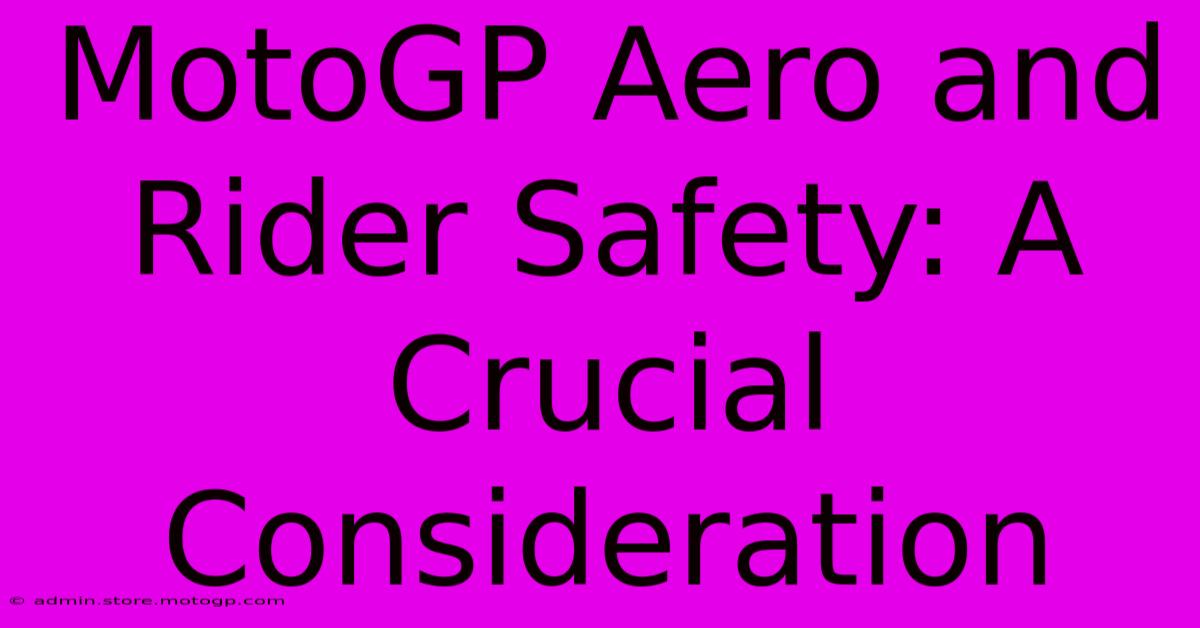MotoGP Aero And Rider Safety: A Crucial Consideration

Table of Contents
MotoGP Aero and Rider Safety: A Crucial Consideration
MotoGP, the pinnacle of motorcycle racing, is a thrilling spectacle of speed, skill, and technological advancement. While aerodynamic advancements have significantly boosted performance, they've also introduced complex safety considerations that demand careful scrutiny. This article delves into the intricate relationship between MotoGP aerodynamics and rider safety, exploring the benefits, risks, and the ongoing efforts to mitigate potential dangers.
The Aerodynamic Advantage: Speed and Stability
Aerodynamics play a pivotal role in MotoGP. Sophisticated aerodynamic packages, including winglets, fairings, and spoilers, are meticulously designed to:
- Increase downforce: This presses the bike to the track at high speeds, improving traction and cornering stability. Higher downforce allows riders to brake later and accelerate sooner, shaving precious seconds off lap times.
- Reduce drag: Streamlined designs minimize air resistance, enabling higher top speeds on straights. This is crucial for overtaking and maintaining a competitive edge.
- Improve stability: Aerodynamic devices help to maintain consistent handling, even during high-speed maneuvers and turbulent air conditions. This enhanced stability contributes to rider confidence and control.
These aerodynamic enhancements are undeniably crucial for performance. However, their impact on rider safety warrants careful consideration.
The Risks Associated with MotoGP Aerodynamics
While offering significant performance advantages, advanced aerodynamics introduce several safety challenges:
- Increased impact forces: The substantial downforce generated can lead to higher impact forces in the event of a crash. The increased grip can also exacerbate the severity of a high-side or low-side crash, resulting in more significant injuries.
- Aerodynamic instability: At certain speeds and angles, aerodynamic devices can become unpredictable, leading to sudden changes in handling that can surprise and overwhelm even the most experienced riders. This instability can be particularly dangerous during close racing situations or in gusty conditions.
- Increased risk of injuries in a crash: The sharp edges and complex shapes of aerodynamic components pose a significant threat to riders in the event of a fall. These parts can cause lacerations, fractures, or even more severe injuries. The increased mass of the aerodynamic package itself also contributes to the overall momentum in a crash, potentially increasing the impact forces.
- The "Tuck and Roll" Technique and its limitations: While riders are trained to "tuck and roll" in case of a crash, the increased downforce from aerodynamic components can make this maneuver more difficult and potentially less effective in mitigating injuries.
Safety Measures and Future Developments
The MotoGP governing body, the FIM (Fédération Internationale de Motocyclisme), and the teams are constantly working to improve safety standards. These efforts include:
- Stringent testing and regulations: Aerodynamic devices are subject to rigorous testing and regulations to ensure they meet safety standards and do not pose an unacceptable risk to riders.
- Improved safety gear: Advances in rider safety equipment, such as airbag suits and reinforced leathers, are vital in mitigating the impact of crashes.
- Track modifications: Improvements to track surfaces and run-off areas aim to reduce the severity of crashes and provide safer environments for riders.
- Ongoing research and development: Constant research into new materials, designs, and safety technologies aims to balance performance gains with reduced risk. This ongoing research is vital to ensuring the future of MotoGP is as exciting as it is safe.
Conclusion:
The quest for speed and performance in MotoGP necessitates sophisticated aerodynamics. However, this technological advancement presents inherent safety challenges. The ongoing collaboration between the FIM, teams, and researchers is crucial in ensuring that the thrill of MotoGP continues without compromising the safety of its riders. A delicate balance must be struck between pushing the boundaries of performance and maintaining a safe racing environment. The future of MotoGP safety depends on this continuing dedication to innovation and safety.

Thank you for visiting our website wich cover about MotoGP Aero And Rider Safety: A Crucial Consideration. We hope the information provided has been useful to you. Feel free to contact us if you have any questions or need further assistance. See you next time and dont miss to bookmark.
Featured Posts
-
The Uncrowned King Of Moto Gp A Case For Riders Name
Feb 18, 2025
-
The Most Exciting Moto Gp Rider Of All Time
Feb 18, 2025
-
Malaysia Moto Gp A Festival Of Speed
Feb 18, 2025
-
Cota Experience The Heart Of Racing
Feb 18, 2025
-
Moto Gps Latest Innovation Sprint Racing Decoded
Feb 18, 2025
